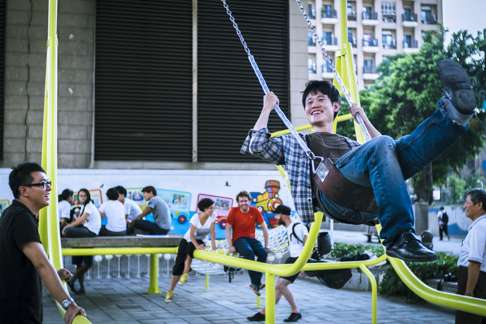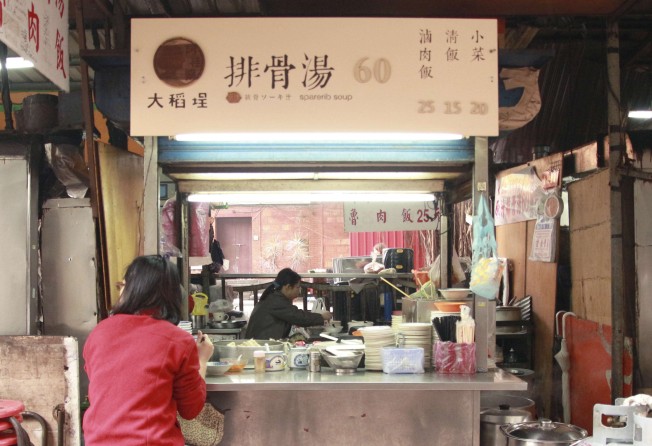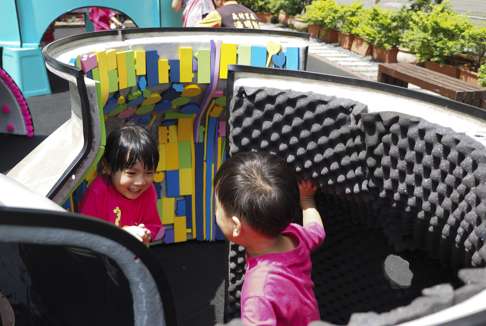
Designers help Taipei government create innovative public spaces
City takes a transformative step with its vibrant signage at Dazhi Market

If you need evidence Taipei has taken design to heart, pay a visit to Dazhi Market, where designers teamed up with hawkers last year to help them rebrand their stalls.
“It looked old-fashioned before,” says the market’s chairman, Huang Shuang-jin. “We are a traditional market but we wanted to add more art and design elements to liven up the atmosphere.”
Nine stall owners in this unassuming neighbourhood wet market volunteered to work with the designers. Together, they produced new signage that replaced the standard government-issued signboards above each stall.

“Customers love it – it’s so cute,” says vegetable hawker Cheng Ming-yen. His customers are now greeted by cartoon veggies with smiling faces. A few stalls down, a fishmonger opted for a more contemporary sign, with a stylish fish logo that wouldn’t look out of place above a gastropub.
The project was led by local design group City Yeast and Archicake Design in collaboration with the Taipei government – just one of many small interventions aimed at improving the city’s quality of life. “A lot of people started to look around [their city] and ask, ‘Is this what we want?’” says Tammy Chen, an Archicake designer.
City Yeast’s efforts were put in the spotlight as Taipei celebrated its role last year as World Design Capital, a distinction awarded by the International Council of Societies of Industrial Design. City Yeast founder Agua Chou Yu-lu says her group’s efforts are part of a new awareness that good design is an essential tool in building a better city.
“I started to become interested in urbanism in 2003, when I was thinking of what design could do to add value to our lives,” says Chou. “It wasn’t anything commercial – it was thinking about the needs of a person, the needs of an area. Three years later, we created City Yeast.”
She started with small, quirky efforts, like asking residents to design their own street furniture. That eventually expanded to more ambitious schemes and collaborations with nearly 1,000 designers in Taiwan and around the world. In the past few years, City Yeast has worked with street sweepers to design new uniforms, and it has embarked on a campaign to help shop owners rework unwieldy commercial signage – a citywide version of what took place in Dazhi Market.

“The core value of the project is we want people to feel a part of it,” says Chou. “It’s not only government officials that are in charge of the process.”
It helps to have government officials on board, of course. In 2011 Taipei hosted the World Design Expo, and Chou felt something change in the way the government perceived design. “Before, they always said no to something new,” says Chou. “Afterwards, they accepted the need to listen to citizens and to designers. They’re more open minded.”
That’s part of a larger transformation that has seen Taipei emerge from its past as a dingy industrial town. In the past two decades, new parks have been built, streets redesigned to be more pedestrian-friendly, a bicycle-sharing system introduced and the government has held international design competitions for major buildings, such as the OMA-designed Taipei Performing Arts Centre, slated for opening this year.

Design thinking has even made its way into Taipei’s waste management system, which has used music-playing garbage trucks, mobile apps and pay-as-you-go garbage bags to boost the city’s recycling rate to 67 per cent, one of the highest in Asia. (By contrast, Hong Kong’s recycling rate is less than 40 per cent.)
Recycling played a role in City Yeast’s most recent initiative, a new playground designed in collaboration with Spanish design firm Basurama. Located in a vacant space beneath an elevated expressway, the designers transformed an old lamp post and water tank into swings and hammocks.
“Most of the parks and playgrounds here are no fun because you can’t do anything,” says Basurama co-founder Mónica Gutiérrez Herrero. Swings are rare because they are considered dangerous, but Basurama and City Yeast were able to persuade the government to let them build one. So far, it has proved more popular than expected. “Even parents fight for the swings with their kids,” says Gutiérrez.
Chou says that since the playground opened last August, the government has asked City Yeast to identify more spaces where it can design innovative public spaces. “The whole environment has changed,” she says. “People have accepted there is a new system.”